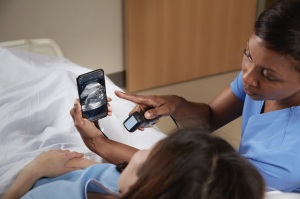by
John R. Fischer, Senior Reporter | April 01, 2019

While handhelds such as Butterfly iQ
may never replace premium ultrasound
systems, they can act as adjunct devices
that provide care in situations where it is
needed immediately, and reduce the
workload of high-end equipment.
From the April 2019 issue of HealthCare Business News magazine
Around 34 million echocardiograms were performed in the U.S. alone in 2017, with volume estimated to increase by about 6 percent annually, according to Dr. Steven B. Feinstein, professor of medicine in the division of cardiology at Rush University Medical Center in Chicago.
“The ultrasound field is growing quickly – with really elegant systems as well as smaller handheld ones that can be used in a variety of settings, and with price points from $2,000 to $200,000,” he told HCB News. “Ultrasound is used in medical schools to teach students. It’s used in the field of trauma and emergency rooms and in lieu of MR and CT in certain clinical scenarios. Ultrasound is truly the frontline for diagnosing cardiovascular issues as well as diseases, tumors and abnormalities throughout the body.”
But producing an accurate echocardiogram is a challenge compounded by a variety of factors, from the patient’s physical attributes, to the technician’s skill and equipment, to the experience of the interpreting doctor. These variables all affect the ability of clinicians to accurately diagnose and treat their patients.



Ad Statistics
Times Displayed: 57392
Times Visited: 1683 Ampronix, a Top Master Distributor for Sony Medical, provides Sales, Service & Exchanges for Sony Surgical Displays, Printers, & More. Rely on Us for Expert Support Tailored to Your Needs. Email info@ampronix.com or Call 949-273-8000 for Premier Pricing.
To address this challenge, clinicians like Dr. Martin Goldman are taking the time to test and validate developing AI and pattern recognition technologies to ensure they are capable of more objectively interpreting and quantifying echocardiograms.
“The same echocardiogram completed by different sonographers and on different equipment may not look like the same final end product. And when it’s delivered to me, as the interpreting doctor, the echo is subject to my interpretation based on my knowledge and experience, which varies with each physician,” said Goldman, who is the associate chief in cardiology and program director at Mount Sinai Heart of the Icahn School of Medicine at Mount Sinai Hospital. “AI can look at a scan, and based upon pattern recognition of several hundred thousand scans, say that the image shows this or that.”
AI is one of many assets that providers in cardiac ultrasound are embracing, along with various other methods of enhanced image quality, automated measurements and 3D visualization. But choosing a system goes beyond just the capabilities it has to offer. It requires an understanding of how each type operates and best meets the needs of a facility’s medical environment, workflow, and most importantly, its patients.
An expanding ultrasound market
Premium cardiac ultrasound systems are designed solely for assessing cardiac conditions. In addition to possessing specially made transducers for echocardiographic exams, these high-end devices (ranging in cost from $100,000-$200,000) offer a range of advanced features, from Color Doppler to dual 2D and 3D visualization to AI-powered automation.

